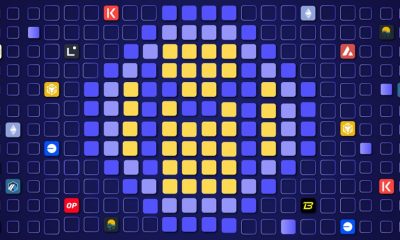Opinion
5 Best Solana Ecosystem Tokens to Watch in January 2022
Securities.io maintains rigorous editorial standards and may receive compensation from reviewed links. We are not a registered investment adviser and this is not investment advice. Please view our affiliate disclosure.

Solana is a blockchain project that aims to offer a rich and safe development platform for new projects, as well as existing ones who wish to migrate or expand to its ecosystem. The project is not that different from Ethereum when it comes to what it offers. However, it differs a lot when it comes to its technical capabilities, specifically speed, scalability, and gas fees.
In fact, Ethereum is partially responsible for Solana becoming as big and as popular as it is today. While Solana is definitely deserving of its rising popularity due to its own qualities, it’s Ethereum’s lack of scalability, slow transaction processing, and great transaction fees that started driving people away.
Ether has always had these problems, but for years since its launch, they were mostly tolerable. However, when 2020 brought the explosion of DeFi, and 2021 did the same to the NFT sector and metaverse, Ethereum’s downsides became more than apparent. People have had enough with its expensive gas fees and slow speeds, so they started searching for alternatives to launch their projects on, and Solana emerged as one of the best solutions. So, here are our top 5 favorite projects that operate on Solana’s network.
1. Arweave
At the top of our list, we have Arweave. This is a leading decentralized storage solution in the Solana ecosystem, and it has received attention — and funding — from some of the largest venture capital companies in the space. Giants like Andreessen Horowitz and Coinbase Ventures, among others, were attracted to the project due to its revolutionizing ideas involving profit-sharing communities that incentivize the devs to use its platform.
Whoever contributes to the ecosystem received equity, which incentivizes people to join the project and get more immersed in it instead of simply purchasing equity.
However, the platform’s main purpose is to offer decentralized storage and to make it limitless. With that in mind, it is easy to understand why the project views itself as a collectively-owed hard drive, which uses blockchain technology for storing information in a safe, transparent, immutable, and approachable way. All information stored on top of the blockchain remains permanently available, which is not only useful for people right now, but also for future generations who might need to view it.
Combining this use case with its incentive program, this project is not only interesting but also highly rewarding for those who engage with it, which might be something to keep in mind if you are looking for something of this kind to invest in.
To learn more about this token visit our Investing in Arweave guide.
2. Audius
Next, we have Audius — a Solana-based decentralized music streaming protocol. Audius was originally created on the POA network, but upon learning of Solana and its benefits, it decided to migrate to its network.
The project emerged with a special goal to fix the inefficiencies that are troubling the music industry. As most people connected to this industry likely know, the industry suffers from a number of problems, primarily the lack of transparency when it comes to music rights ownership. Another problem that plagues the industry is the number of unavoidable intermediaries that have placed themselves between artists and their audiences.
These intermediaries charge massive fees while doing a minimum amount of work, and at the same time, they are taking from artists and audiences alike. By using Audius, artists stand to gain direct access to their communities, which would allow them to lower the prices of their content and still receive more money than ever before, as they could simply be able to publish it at no cost. Similarly, community members would have to pay less, or even nothing to enjoy this content.
Not only that, but the community could even stake AUDIO tokens — the project’s native cryptocurrency — and help their favorite artists grow.
To learn more about this token visit our Investing in Audius guide.
3. Raydium
Halfway down the list, we have Solana’s first-ever automated market maker (AMM) — Raydium. Since it is the first project of this kind, Raydium has unique access to first-mover advantage, and it is using it in full.
The project is acting as a liquidity provider for a decentralized exchange called Serum DEX. All of the funds that get deposited into Raydium are being converted into limit orders, and these orders then sit on Serum’s order books.
Raydium quickly became a popular project in Solana’s ecosystem, and its smart contracts reached $1 billion locked a long time ago. It is currently one of the most widely used dApps in the entire Solana ecosystem, where it also runs its project accelerator — AcceleRaytor. Its user base continues to grow daily, which is quite promising for the future of its native token, RAY.
To learn more about this token visit our How to buy Raydium guide.
4. Serum
Speaking of Serum, this decentralized exchange deserves its own place on this list. The project aims to become the biggest and most dominant DEX on Solana and rival the likes of Ethereum’s Uniswap or Binance Smart Chain’s PancakeSwap.
Serum offers all the benefits of decentralization one would expect from a DEX, but it also manages to provide benefits that people have gotten used to while using centralized platforms. Serum. The project is not like Uniswap and PancakeSwap, both of which act as AMMs that allow users to swap cryptocurrencies. Instead, Serup is a full-featured exchange. It even offers access to trading with leverage, limit orders, and other features that you would expect on an exchange.
Furthermore, the project offers great speeds thanks to Solana’s fast chain, which directly leads to low transaction costs.
To learn more about this token visit our Investing in Serum guide.
5. Star Atlas
Lastly, we have Star Atlas. This is a gaming platform based on Solana’s blockchain, that relies on NFTs. The project emerged in August 2021, just as the NFT sector was at its strongest, and blockchain gaming that relies on NFTs started becoming popular. Under these conditions, Star Atlas thrived, attracting attention from the project’s entire community.
It developed a game set in a virtual reality universe, where players get to purchase and own spaceships that they can use to travel through the universe, explore other planets, and even engage in battles with other players. Winning in these battles brings rewards that make the whole experience that much more rewarding. In other words, this is not just a game to pass the time, but also one where players can earn, improve their ships, and more.
There are three factions to choose from when selecting your player character — mankind, sentient androids, and a consortium of alien races. The game also includes multiple genres, combining exploration & exploitation, battles, and more, and at the same time, you get to earn virtual assets that can be exchanged for real-life currencies, used for buying NFTs, trading, and more.
To learn more about this token visit our How to buy Star Atlas guide.
Conclusion
As you can see, Solana does not lack innovative, diverse projects and protocols. These are only some of what Solana has to offer, so if you are looking for more great projects to invest in, definitely check out SOL’s ecosystem.












